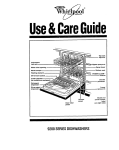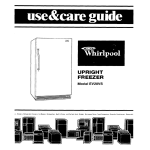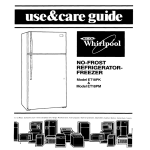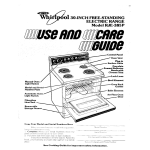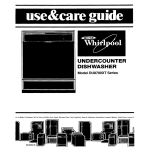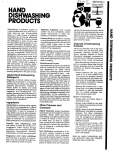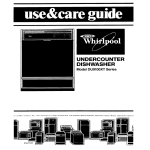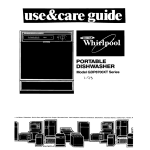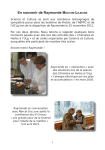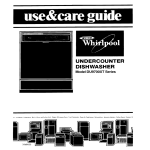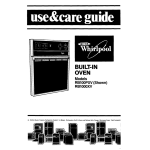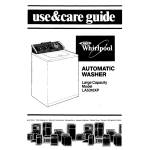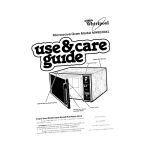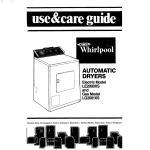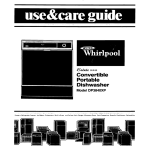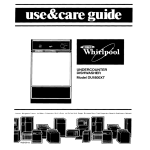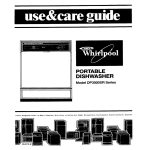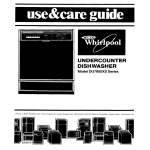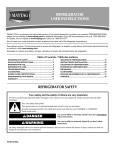Download Whirlpool DU8350XT User's Manual
Transcript
s j 11 UNDERCOUNTER DISHWASHER Model DU8350XT Series Contents Qlye BEFORE YOU USE YOUR DISHWASHER IMPORTANT SAFETY INSTRUCTIONS PARTS AND FEATURES FOR BEST RESULTS The Filtering System Water Must Be Hot Quiet Operating Tips PROPER LOADING Top Rack Loading ” Bottom Rack Loading Silverware Basket Loading ADDING DETERGENT. The Detergent Dispenser Page How Much Detergent to Use RINSE AID DISPENSER. BEFORE STARTING YOUR DISHWASHER, STARTING YOUR DISHWASHER. Selecting a Cycle HEAT DRY or AIR DRY? : Changing a Setting To Add a Dish After Starting ENERGY SAVING TIPS. SPECIAL TIPS ON DISHWASHER USE. COMMON DISHWASHING PROBLEMS., IF YOU NEED SERVICE OR ASSISTANCE, WHIRLPOOL DISHWASHER WARRANTY L 2 3 4 4 4 4 5 5 6 6 7 7 01989 Whirlpool Corporation Before you use your dishwasher It is your r&ponsibility to be sure your dishwasher: Is installed by a qualified installer. l Has been installed where it is protected from the elements. l Has been installed on a floor strong enough to support its weight. l Has been properly connected to electricity, water and drain.* l Has been properly electrically grounded.* l Has had all hang tags and temporary labels removed. l Is not used by children or anyone unable to operate it properly. l Is properly maintained. *See Installation Instructions for complete information. l Important safety instructions To reduce the risk of tire, electrical shock, or injury when using your dishwasher, follow basic precautions including the following: Read all instructions before using the dishwasher. l DISHWASHER MUST BE ELECTRICALLY GROUNDED. Read the Installation Instructions for details. l Be sure your dishwasher is installed on a level floor that will hold the weight, and in an arec! suitable for its size and use. l When discarding an old dishwasher, always remove the door to prevent accidental entrapment. l REMEMBER, use your dishwasher only for the job It was designed to do. l Store dishwasher detergent in a cool, dry place WHERE CHILDREN CAN’T REACH IT. l Use ONLY detergents and rinse aids recommended for use in a dishwasher. l Locate sharp items and knives so that they are not likely to damage door seal or cut the user l DO NOT let children play in or on the dishwasher. * DO NOT reach into the area below the botl tom rack until the heating element has cooled for at least 20 minutes. l DO NOT wash plastic items unless marked “Dishwasher Safe” or the equivalent. If not marked, check manufacturer’s recommendations. l DO NOT use your dishwasher unless all enclosure panels are properly in place. * DO NOT sit on, stand on or abuse the dishwasher door or dish racks. l DO NOT tamper with controls. l If hot water has not been used recently [usually two weeks or longer), hydrogen gases may build up in the water heater and the hot water pipes. HYDROGEN GAS IS EXPLOSIVE. To prevent injury or damage, before using your dishwasher, turn on all hot water faucets and allow water to run for several minutes. This will allow gases to escape. Do not smoke or use any open flame near the faucet while it is open. l Disconnect electrical power to the dishwasher before attempting to service. - SAVE THESE INSTRUCTIONS - 7 7 8 8 8 9 9 9 10 11 42 14 16 Parts and features Model DU8350XT Series BOTTOM RACK RACK BUMPER PROTECTOR is designed to prevent too much water from DETERGENT DISPENS (Permanent Label) Thank you for buying a Whirlpool appliance. Please complete and mail the Owner Registration Card provided with this product. Then complete the form below. Have this information read 4 If you iced service or call with a question l l Copy Moo II and Serial Ncrmbers from plate (see diagram c .)ove) and purchase date from sales slip Keep this b lok and sales slip together in a handy place Model Number Serial Number Purchase Service Date Comoanv Phone Number For Best Results Your dishwasher cleans by spraying a mixture of hot, clean water and detergent against soiled surfaces of dishes. When a cycle is started, the dishwasher fills with waterto about the level of the heating element. This water is pumped through the rotating spray arms, drained through the filter system which removes food and soil, and pumped back through the rotating spray arms. Soiled water is pumped out and replaced with clean water during a cycle-the number of times depends on the cycle being used. Load dishes so soiled surfaces erful spray from rotating arms. face pow- The self-cleaning filtering system and removable pump guard help eliminate prerinsing by removing food particles from the The filtering system It is not necessary to rinse dishes before putting them into the dishwasher. Just remove large pieces and quantities of food and bones. The filtering system helps keep food particles out of the wash water. Small particles are flushed away as water is pumped out. Larger particles are trapped in the pump guard. To remove the pump guard for cleaning. 1. Wait at least 20 minutes after a cycle for the heating element to cool down. 2 Unload and remove the bottom rack. 3. Press the outside wall of the pump guard at the center to release the latch. 4. Lift out and rinse clean. To replace the pump guard... 1. Insert pump guard legs (on inside wall) into matching openings in filter screen. 2. Press down on outside wall until latch snaps into place. 3. Replace bottom rack with rack bumpers in front. Water must be hot Check Water Temperature For best cleaning and drying results, 140°F (60°C). 1. Turn on hot water faucet nearest the until it is as hot as possible. 2. Hold a candy or meat thermometer to measure the temperature. 3. If the temperature is too low, have a the water heater thermostat setting. water should dishwasher. be at least Let water run in the stream of hot water qualified person raise Quiet operating tips To avoid thumping and claftenng noises during operation: l Make sure lightweight load items are secured in the rack. l Make sure pot lids and handles, pizza pans, cookie sheets, etc. do not touch interior walls 4 or interfere with either of the spray arms rotation. . Load dishes so they don’t touch one another. NOTE: Keep sink dmin plugs inserted during dishwasher opemtion to prevent noise transfer through drains. Proper loading Always load dishes so soiled surfaces are reached by spray from rotating Water must be able to drain off completely for best drying results. Be careful items so spray can reach all surfaces. Top rack spray arms. to separate loading UP AND GLASS LOAD The top rack is designed for cups, glasses and smaller items. . Place so open ends face down for cleaning and draining. . load glasses in top rack only. Bottom rack is not designed for glasses. Damage may occur. l l Load plastic items in the top rack only. Only plastic items marked “dishwasher safe”’ are recommended. Plastic items can be melted in the bottom rack. . Items with cooked-on soiled surfaces facing or dried-on the spray. foods Place items in the rows between prongs. Placing them over the prongs can lead to breakage. Be sure lightweight items are held firmly in place. China, crystal and other delicate items must not touch each other during dishwasher operation. Damage may occur. l l l l Small bowls, pans and other be placed in the top rack. should be loaded in the bottom UtenSik rack with can Bottom rack loading Siheruare ha3het loading Ldaa ‘arics ana spoons s.z theL don’t nest together. SD~CIY;a” * r+:acb viested Items NO Make sure pot handles and other items do not stop rotation of either the upper or lower spray arm. Spray arms must move freely. Load items so they do not block or cover the spray tower. Securely place heavily soiled cookware face down in rack. l l l YES Mix items in each section of the basket with some pointing up and some down. Small items - baby bottle caps, tar lids, etc. - can be put in any section. Make sure sharp items (knaves. skewers, etc ] are put in point down forks, The silverware basket can be loaded while it’s In place on the door, or it can be taken out for loading on the Counter or table It can also be removed for easy unloading Always unload or remove the basket before unloading the racks to avoid spelling water droplets on the l Place plates, soup bowls, etc., between prongs and facing the spray To remove the basket, slide it toward the top of the door - by the handle. Lift it off the holding buttons. Replace it in reverse order. l 6 Load cookie sheets, cake pans and other large items at sides or back. Loading such items in front may keep water spray from reaching detergent dispenser and srlverware basket. NOTE: l Do not load glasses, cups or plastic Items in the bottom rack. l When lower rack is removed, replace with bumpers in front. To open the basket, as shown. Be sure the cover is completely latched before pulling out the bottom rack and before closing the drshwasher door. unhook the latch Adding detergent The kind and amount of dishwasher detergent you use is an important getting your dishes clean. Read this section carefully. Use automatic washer detergent The detergent dispenser dishonly. The detergent dispenser has one section with a cover and one without. l Put detergent in both sections for cycles with two washes. l Put detergent in the covered section only for cycles with one wash. l Push the cover down until it is latched. Detergent in the open section falls into the dishwasher when the door is closed. The covered section opens automatically when the main wash starts. NOTE: It is normal for cover to open partially when dispensing detergentThe coverwill open fully when the door is opened. Other detergents are too mild and much too sudsy to work in the dishwasher. Different brands of dishwasher detergent have different amounts of phosphorus, Phosphorus softens water and helps prevent water spots on dishes. \ ,\!L If water is hard and phosphorus content is low (6.0% or less), you may need to use more detergent or use a brand with a higher phosphorus content (8.7% or higher). COVER Do not add detergent until you are ready to wash. Fresh automatic dishwasher detergent is necessary for best washing results. Store detergent tightly closed in a cool dry place. Use covered section LIGHT WASH Cycle How much part of detergent to use The amount of detergent to use depends on the hardness of your water. If too little is used, dishes won’t be clean. However, if too much is used in soft water, glassware will begin to etch. Find out your water’s hardness by asking your local water department, water softener company or county extension agent. COVER LATCH for. _. I 1’ Use both sections for.. . POTS&PANS Cycle NORMAL WASH Cycle HARD - Fill 1 or both sections to top line if water hardness is 8 or more grains per gallon, or 136 or more parts per million. l MEDIUM - Fill 1 or both sections to middle line if water hardness is 5 to 7 grains per gallon, or 85 toll9 parts per million. . SOFT - Fill 1 or both sections to bottom line if water hardness is 0 to4 grains per gallon, or 0 to 68 parts per million. l Rinse aid dispenser A rinse aid helps keep water from forming droplets and drying as spots. Keep the dispenser filled with a rinse aid such as JetDry.” A small amount is released automatically during the final rinse of each cycle. Check the dispenser periodically to see if it needs refilling. An “E” will be visible inside dispenser when it is empty Make sure dishwasher door is fully open when refilling. Do not fill past the smallest opening in the lower part of the dispenser. If you overfill, excess rinse aid can come out. This will not harm the dishwasher. Keep the dispenser fill cap tightly closed. 3 Before starting your dishwasher 1. Read “Important Safety Instructions” on page 2 before starting your dishwasher. 2. Spin the Upper and Lower Spray Arms to make sure nothing will stop them from turning freely. 3. Push door firmly when closing and it will automatically latch. 4. Run hot water at sink nearest dishwasher until it is hot. Turn it off. CYCLE SELECTOR BUllON OPTION SELECTOR BUTTON Starting your dishwasher POTS & PANS Cycle... NORMAL WASH Cycle... 1. Turn Cvcle 1. Turn Cycle Control Knob clockwise to dot markedl POTS &. PANS. [POTS & PANS and NORMAL WASH Cycles share the same spot on the dial. The Selector Buttons determine which cycle operates.) The dishwasher will automatically start. Button only. 2. Push the POTS & PANS Selector (The HEAT DRY option is preset. The AIR DRY option cannot be selected.) Control Knob clockwise to dot marked NORMAL WASH. (NORMAL WASH and POTS & PANS Cycles share the same spot on the dial. The Selector Buttons determine which cycle operates.) The dishwasher will automatically start. 2. Push the HEAT DRY or AIR DRY Selector Button. LIGHT WASH Cycle... 1. Turn Cycle 1. Turn Cycle Control Knob clockwise to dot marked LIGHT WASH. The dishwasher will automatically start. 2. Push the HEAT DRY or AIR DRY Selector Button. Selecting a cycle POTS 81 PANS Cycle Maximum cleaning for cookedor baked-on foods Timer delays while the dishwasher automatically heats the water to 145 F (63 C] in both washes and the last rinse (marked l ). Cycle time will be about 1% to 2 hours, depending on time needed to heat water. NORMAL WASH Cycle A double wash for normal to heavily soiled loads. (The Energy Guide Label data IS based on this cycle.] Cycle time IS about 63 minutes. LIGHT WASH Cycle For normal,everyday Cycle time is about soiled loads 58 minutes. RINSE & HOLD Cycle... Control Knob clockwise to dot marked RINSE & HOLD. The dishwasher will automatically start. 2. Push the AIR DRY Selector Button only. RINSE & HOLD Cycle For rinsing a few items to be washed one or more days later. Cycle time is about 12 minutes. Use AIR DRY only HEAT DRY or AIR DRY? If the HEAT DRY Option is selected, air in the dishwasher is heated during the “dry” part of the cycle. If the AIR DRY Option is selected, air in the dishwasher is not heated. Using this option helps Changing a setting You can change a setting anytime during any cycle. 1. Lift up on the door latch to unlatch the door and stop the cycle. Don’t open the door until the spray arms stop spinning. To add a dish after starting 1. To be sure the added item is washed and rinsed, make sure the Cycle Control Knob has not passed LIGHT WASH. 3. Lift up on the door latch to unlatch the door and stop the cycle. Don’t open the door until the spray arms stop spinning. save energy, but dishes ta ke longer night] and some water spotting Some items (such as plastics) may drying. For best results, use a liquid rinse Jet-Dry.” to dry (overmay result. need towel aid such as 2. Turn the Cycle Control Knob clockwise to the cycle you want. 3. Be sure the detergent dispensers are filled properly for the new cycle. 4. Press door firmly to latch it. The dishwasher will automatically start the new cycle. 3. Open the door and add the dish. 4. Close the door. Do not latch it. Wait 30 seconds for air in the dishwasherto warm up. This helps reduce the amount of moisture that can come from the vent when restarting the cycle. 5. Press door firmly to latch it. The dishwasher will automatically start where it stopped. Energy saving tips You can help save energy if you: 1. Wash full loads. Running a half-filled dishwasher uses the same amount of electricity and hot water as a fully loaded machine. 2. Use the LIGHT WASH Cycle for normally soiled loads. It uses less hot water and energy than other wash cycles. I 3. Air dry dishes drying cycle. (overnight). when you don’t need a rapid Allow longer drying times 4. load correctly for best washing results. Incorrect loading may cause poor washing and the need to rewash all or part of the load. 5. Don’t pre-rinse normally soiled dishes. Select the correct cycle for the load and use the recommended amount of detergent for good washing results without hand rinsing. 6. Use your dishwasher during off-peak hours. Local utilities recommend this to avoid heavy usage of energy at certain times of day can be done quickly and 7. Kitchen cleanup efficiently through the use of your dishwasher. Most appliance parts that can fit in the dishwasher can be cleaned by it. Burned-on soil, however, should be cleaned by hand. Special tips on dishwasher use Remember, use your dishwasher only for the job it was designed to do. Some items are not dishwasher safe or may require special care. Read these special tips for the following items: AhUUiIUlIU: Aluminum loses its bright, shiny appearance and darkens in color due to minerals the water and the alkalinity of the dishwasher detergent. Colored aluminum may fade. in TIPS: If washed in the dishwasher avoid placing directly in front of detergent dispenser where it could be sprinkled with undissolved detergent, causing spotting, pitting, and discoloration. Follow utensil manufacturers’ cleaning instructions. China: Hand-painted, metal-trimmed, and antique china fade due to high water temperatures and alkaline detergent solution in the dishwasher. NOTE: Delicate, antique items should not be washed in the dishwasher. TIPS: Load china carefully. Do not allow pieces to touch each other. Test one piece by washing it daily in the dishwasher for several weeks. Then compare it with the rest of the set to see if colors have changed. and decorative crystal &NS6!S: Crystal can break from sudden exposure to high Metal trim and colorful decoration on glass will fade in time when washed NOTE: Delicate, antique items should not be washed in the dishwasher. temperatUre. dishwasher. water in the TIPS: Load crystal carefully in top rack only. Be sure to load a few larger items in the bottom rack reduce amOUnt of force of water spray reaching glassware from lower spray arm. Use the shortest cycle. t0 Flatware: Salty and acidic foods may tarnish silver and stainless flatware if allowed to remain on the utensils. A film may form on sterling silver and silver plate items washed in a dishwasher. This film is caused by a reaction of silver with chlorine in the detergent. Gold flatware is not dishwasher safe. The adhesive used in some flatware with hollow handles is not heat resistant, causing the handles to come off in the dishwasher. Wash by hand. TIPS: Rinse flatware as soon as possible, especially if it is notto be washed right away. Dishwasher detergent may remove antique finishes. Wash by hand.Tarnish and film build-up can be removed with silver polish. Cast irOIl UteUSiiS: The seasoned finish will be removed TIPS: Wash by hand. To re-season, coat with unsalted PlaStiCS: Many plastics will have sensitive and may melt or warp. TIPS: If in doubt, protection. try one piece. Non-stick finish UteUSik TIPS: Follow manufacturers’ Wood: Many wooden Pewter or pewter-like pewter Place Safe” written in upper Rusting will result. fat and heat in a slow oven for an hour or two. on them. Some plastics rack only. AIR DRY option Most can be washed provides are heat additional in the dishwasher, suggestions. items will crack TIPS: Do not wash cutting dishwasher. TIPS: To keep “Dishwasher in the dishwasher. boards, Ulaterids: and warp wooden or lose their finish. salad bowls or knives May streak, discolor, with wooden handles in the and pit. at its very best, hand wash with mild detergent. Dishwasher care & cleaning: Exterior - Regular use of a soft damp cloth or sponge and a mild detergent is all that is necessary, in most cases, to keep the outside of your dishwasher nice looking and clean, Interior - Hard water minerals may cause a white film to build-up on the inside surfaces, especially just beneath the door area. Wear rubber gloves when cleaning the dishwasher interior. Do not use any type of cleanser other than dishwasher detergent because it may cause foaming or sudsing. 11 Common dishwashing problems PROBLEM Spottlng fllmlng and CAUSED BY SOLUTION Hard water Fill detergent tergent with be necessary dispensers to capacity Use dishwasher highest available phosphorus content to install water softener deMay To remove spots and film. try a vinegar rinse. 1 Wash and rinse load as usual. Use AIR DRY. 2. Remove all metal items. 3. Put 2 cups (500 ml) white vinegar In a container on the bottom rack. 4. Run dishwasherthrough a complete washing cycle Waler IS not hot enough Water temperature should be at least 140 F (60 C]. Set water heater thermostat to a higher setting. Run water at sink until hoi before starting, Not enough detergent, or Improper detergent Use more dishwasher detergent. Use delergent est available phosphorus content...especially water. “Old” Use only fresh dishwasher detergent. Store tightly container in cool, dry place. Discard old detergent. fill dispensers until ready to start dishwasher. detergent Improper loadlng No rinse old AIR DRY Setting Small particles deposlted on items Dishes not dry Chlpplng breaklng glassware 12 or on closed Do not Make sure dishes and glassware are loaded so spray reaches all surfaces and items drain properly Do not overload Do not nest items Make sure large items do not block spray from reaching detergent dispensers. Does the rinse aid dispenser need filling? See InstructIons on page 7 Drying without heat may result in some spotting of glasses and silver. Spray arm or arms not rotating freely “0ld”detergent Check spray arms to make sure they turn freely after loading. Be sure a utensil has not prevented theirturning Use only fresh dishwasher detergent. Store tightly closed container in cool, dry place. Discard old detergent. Do not fill dispensers until ready to start dishwasher. Not enough detergent, or Improper detergenl Use more dishwasher detergent Use detergent est available phosphorus content. especially water Water IS not hot enough Water temperature should be at least 140 F (60 C). Set water heater thermostat to a higher setting Run water at sink until hot before starting. Water pressure may be low. dishwasher is not filling properly If water pressure while dishwasher Water is not hot enough Water temperature should be at least 14O‘F (6O’C). Set water heater thermostat to a higher setting. Run water at sink unhl hot before starting Improper Make sure dishes and glassware are loaded reaches all surfaces and Items drain properly erload Do not nest items loading No rinse aid AIR DRY Setting Black marks dlshes used with highwith hard IS low, do not use waterforother is running [to assure correct with highwith hard purposes fills) so spray Do not ov- Fill rinse old dispenser. used Allow more time when using AIR DRY Option. DRY Plastic items may need towel drying or use HEAT Aluminum utensils rubbing against items during washing Use care In loading alumlnum utenslls, especially any llghtwelght toll container. Place so they do not touch dlshes. Remove black marks with plastic scouring pad and a mild abrasive cleanser. Improper Do not overload Load glasses in the top rack only. Load between prongs, not over them Glasses loaded over prongs will not be supported and may chip or break. loading PROBLEM CAUSED BY SOLUTION Dlshes not washing clean Water is not hot enough Water temperature should be at least 140°F (60°C). Set water heater thermostat to a higher setting. Run water at sink until hot before starting Improper Make sure dishes and glassware are loaded so spray reaches all surfaces and items drain properly. Do not overload. Do not nest items. Make sure large items do not block spray from reaching detergent dispensers. loading Spray arm or arms not rotating freely Not enough detergent or improper detergent “0ld”detergent Waterpressuremay be low, dishwasher not filling properly is Check spray arms to make sure they turn freely after loading. Be sure a utensil has not prevented theirturning. Use more dishwasher detergent. Use detergent with highest available phosphorus content...especially with hard water Use only fresh dishwasher detergent. Store tightly closed container in cool, dry place. Discard old detergent. Do not fill dispensers until ready to start dishwasher, If water pressure is low, do not use water for other purposes IS running [to assure correct fills). while dishwasher Check for rainbow hue on glasses. A rainbow hue is the first sign of etching (corrosion of glass). Reduce the amount of dishwasher detergent Use a detergent with a lower phosphorus content. If water pressure is low do not use water for other purposes while dishwasher is running (to assure correct water fills]. Make sure dishes and glassware are loaded properly to assure adequate rinsing and dratning. Do not overload. Cloudy tllm on glassware, etching permanent corrosion Too much detergent in soft water Dlshes & lnterlor of dlshwasher yellow or brown Iron or manganese water Rust spots on stalnless steel -ORDark spots on flatware stalnless steel, sliver plate, or sterllng Allowing salty or acidic foods such as mayonnaise, vinegar. fruit juices, salad dressings, milk products to remain on flatware. Undissolved detergent coming in contact with flatware Rinse flatware that is‘ to stand for several washing [use Rinse &Hold]. Clean stained polish and re-wash. Do not put stalnless flatware In the same sllverware basket Direct contcct between these metals can nent damage to the sllver. Bronze tarnish on silverplate Silverplate is worn off Exposed base metal takes on a bronzed hue. Remove Water left in bottom of dishwasher Dishwasher cycle not completed Clogged drain air gap Allow Inadequate rinsing in Temporary remedy: 1 Set empty dishwasher for a “one wash” cycle. 2. Start dlshwasher and unlatch door to stop it when it has filled for the wash part of the cycle. 3 Add ‘/k to 1/Z cup (120 to 240 ml] of citric acid crystals (usually available in drugstores). 4 Close and latch door to complete cycle. Permanent solution: Install an iron or manganese filter to home water supply Remove spots with silver polish. Avoid detergent on wet flatware. tarnish dishwasher with silver polish. to complete hours before items with silver steel and sliver compartment. cause perma- spilling Have silver concentrated replated cycle. Some plumbing codes require use of a drain air gap between an undercounter dishwasher and the drain system of the house. The air gap is usually located above the sink or on the top of the counter near the dishwasher to prevent the possibility of water backing up from the drain into the dishwasher due to a plugged drain. The drain air gap is NOT a part of the dishwasher and is NOT covered by the dishwasher warranty. The drain air gap should be kept clean to ensure proper draining of the dishwasher. If you need service or assistance, we suggest you follow these five steps: 1. Before calling for assistance... 3. If you need service*... Performance problems often result from llttle things you can find and fix yourself without tools of any kind If your dishwasher will not run, or stops during a cycle: l Is the door tightly closed and securely latched? l Has the cycle been correctly set? l Is the water turned on? l Have you checked your home’s main fuses or circuit breaker box? l Is the dishwasher wired into a live circuit with the proper voltage? l If the motor has stopped because of an overload, it will automatically reset itself within a few minutes. If the motor does not start, call for service. If your dishwasher seems to run too long: l Are you using POTS & PANS Cycle? The dishwasher may be waiting for the water to heat. l Is your household water temperature set too low? Low water temperature settings will cause longer dishwasher operating times. If water remains in the dishwasher: l Has the cycle completed? l A small amount of remaining water is normal. l Is drain air gap clogged? If detergent remains in the covered detergent cup: l Is the bottom rack in backwards? [The rack bumpers should be at the front.) l Is the dishwasher detergent fresh and dry without lumps? l Is the cycle completed? 2. If you need assistance?.. Call Whirlpool COOL-LINEm service assistance telephone number. Dial free from anywhere in the U.S.: 1-800-25343Ol and talk with one of our trained consultants. The consultant can instruct you in how to obtain satisfactory operation from your appliance or, if service is necessary, recommend a qualified service company in your area. 14 Whirlpool has a nationwide network of franchised TECH-CARE ” Service Companies. TECH-CARE service technicians are trained to fulfill the product warranty FRANCHISED SERVICE and provide afterwarranty service, anywhere in the United States. To locate TECHCARE service tn your area, call our COOL-LINE service assistance telephone number (see Step 2) or look in your telephone directory Yellow Pages under: APPLIANCES HOUSEHOLD MAJOR SERVICE 8 REPAIR OR ELECTRICAL APPLIANCES MAJOR. REPAIRING 8 PARTS WASHING MACHINES, DRYERS 8 IRONERS - SERVICING 'Wt~lHLPOOL APPLIANCES FHANCH!SED TECWCARE SlAVICE .SEHI /C‘E c O.~f/'A.\/F.S XYI SEHL'ICE CO '23 vcg'r '199.9999 4. If you have a problem%.. Call our COOL-LINE service assistance telephone number (see Step 2) and talk with one of our consultants, or if you prefer, write to: Mr. Donald Skinner Director of Customer Relations Whirlpool Corporation 2000 M-63 Benton Harbor, Ml 4%?: Please include a daytime p:%-ine rumber in your correspondence. 5. If you need FSP” replacement parts?. . FSP is a registered trademark of Whirlpool Corporation for quality parts. Look for this symbol of quality whenever you need a replacement part for your Whirlpool appliance. FSP replacement parts will fit right and work right, because they are made to the same exacting specifications used to build every new Whirlpool appliance. To locate FSP replacement parts in your area, refer to Step 3 above or call the Whirlpool COOLLINE service assistance number in Step 2. ‘If you must call or write, please provide: model number, serial number, date of purchase, and a complete description of the problem. This information is needed in order to better respond to your request for assistance. Notes WHIRLPOOL” DIMWASHER WARRANTY LENGTH OF WARRANTY WHIRLPOOL I FSP replacement parts and repair labor to correct defects in materials or workmanship. Service must be provided by a franchised TECH-CARE@ service comaanv , FULL ONE-YEAR WARRANTY From Date of Purchase LIMITED NINE-YEAR WARRANTY Second Through Tenth Year From Date of Purchase WHIRLPOOL DWOO: 1 1 WILL PAY FOR FSP realacement of the aorcelain tub and/or DURAPERM* inner door ihould they fail to contain water due to defective materials or workmanshlp WILL NOT PAY FOR A. Service calls to: 1. Correct the installation of the dishwasher 2. Instruct you how to use the dishwasher 3. Replace house fuses or correct house wiring or plumbing 6. Repairs when dishwasher is used In otherthan normal, single-family household use, C. Pick up and delivery. This product is designed to be repaired in the home. D. Damage to dishwasher caused by accident, misuse, fire, flood, acts of God or use of products approved by Whirlpool. E. Any labor costs during limited warranty. not WHIRLPOOL CORPORATION SHALL NOT BE LIABLE FOR INCIDENTAL OR CONSEQUENTIAL DAMAGES. Some states do not allow the exclusion or limitation of incidental or consequential damages so this limitation or exclusion may not apply to you. This warranty gives you specific legal rights, and You may also have other rights which vary from state to state. Outside the United States, a different warranty may apply. For details, please contact Your franchised Whirlpool distributor or military exchange. ‘Tmk Part No. 3368024 Rev. C 861989 Whirlpool Corporation akers Olshwashers BullI-In Ovens and Surlace tln~ls Ranges Printed Microwave Ovens Trash Compactors Room Air Condllloners Oehumldihers Aulomallc Washers Clolhes Oryers in U.S.A. Freezers Relrlgeralo
















